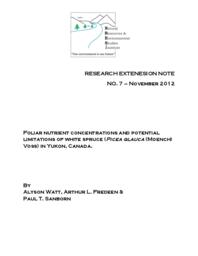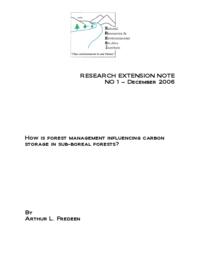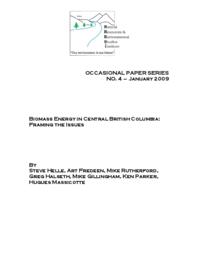Fredeen, Arthur
Person Preferred Name
Arthur Fredeen
Related Works
Content type
Digital Document
Description / Synopsis
"Although nutrient deficiencies are not uncommon in forests across the north, little is known about these limitations in the Yukon, and even less about how these limitations have been and/or will be affected by climate. To address existing edaphic limitations to forests in the Yukon, an investigation of the nutrient concentrations of white spruce (Picea glauca (Moench) Voss) foliage was undertaken throughout various regions of Yukon in 2009. By comparing individual nutrient concentrations to critical values and reviewing nutrient ratios, the results identified nitrogen (N) as being commonly severely deficient. Phosphorus (P) and sulphur (S) were also commonly deficient, whereas magnesium (Mg) and potassium (K) were mostly adequate with few reports of slight deficiency levels. In contrast, calcium (Ca) was adequate at all locations. Of the micronutrients, zinc (Zn) and manganese (Mn) were the only elements in adequate supply at all sites while slight to moderate deficiencies were commonly indicated for all other micronutrients across the study area. Nutrient limitations may ultimately restrict the growth response of white spruce to climate changes and/or increasing atmospheric CO₂."
Origin Information
Content type
Digital Document
Description / Synopsis
"A major question for Kyoto signatory nations such as Canada is what role our forests might play in meeting our greenhouse gas emission reduction commitments. The most important greenhouse gas affected by human activity is carbon dioxide (CO₂). Forests contain high amounts of carbon, which reflect the net balance between photosynthetic fixation of CO₂ into tree products - primarily cellulose - and the return of this carbon back to the atmosphere through respiration and fire. In this paper I integrate two aspects of my sub-boreal forest carbon research program, both conducted at the Aleza Lake Research Forest (ALRF) 60 km east of Prince George, BC. Clearcuts are sources of carbon for two reasons. First, primary forests contain >250 tonnes per hectare while new clearcuts contain <150 tonnes per hectare; loss of tree carbon is immediate and large. However, even after accounting for harvesting, clearcuts are net carbon sources (input CO₂ into the atmosphere) for >8 years after harvesting while belowground respiration exceeds photosynthesis. These carbon losses total 33 tonnes per hectare over 8 years, despite gains of 1 to 1.2 tonnes per hectare per year by the regrowing forest. Partial cut harvesting conserves the greatest amount of carbon. In balance, and after taking into account different forest management types, the entire upland region of the ALRF (6,035 hectares) has been essentially neutral with respect to carbon over the past 10 years. Thus, current forest practices and harvest levels at the ALRF appear to be sustainable with respect to carbon."
Origin Information
Content type
Digital Document
Description / Synopsis
"Bioenergy, or energy derived from biomass, was the predominant energy source for humans from prehistory to the mid-19th century. With on-going energy security issues, rising greenhouse-gas (GHG) levels driven by fossil fuel energy consumption and volatile natural resource prices, the biomass energy of yesterday is now being re-evaluated as the energy source for tomorrow. The technology of bioenergy production has evolved considerably in recent years, such that heat, electricity and liquid fuels for transportation can all be derived from a wide variety of biomass starting materials. Though the transformation of sunlight energy into chemical biomass energy in plants is in theory an endlessly renewable process, the way in which we manage our lands to generate this biomass energy can be degradative and unsustainable when all of the land-use values are taken into account. This paper evaluates bioenergy through the prism of sustainability, highlighting issues relating to the physical and temporal scales of the resource and impacts of its use, technological opportunities and limitations, net environmental impacts, and community concerns and needs. The geographic focus is the central interior of British Columbia, however, the issues raised in this paper will be relevant to all locations considering bioenergy."
Origin Information



